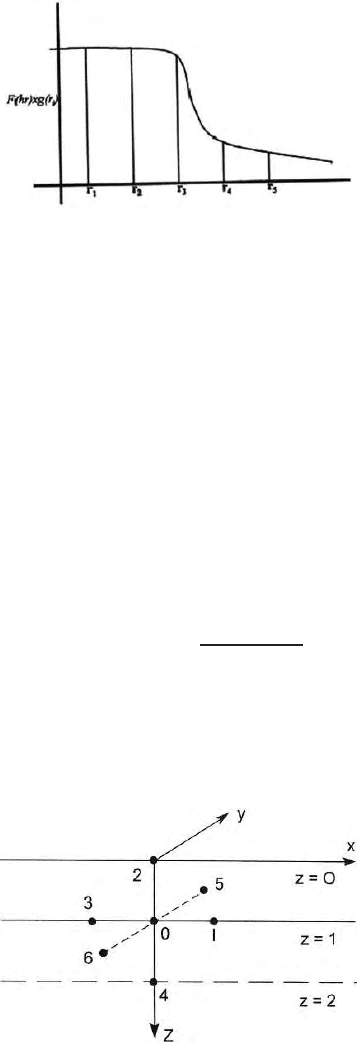Roy K.K. Potential theory in applied geophysics
Подождите немного. Документ загружается.


16.5 Analytical Continuation using Integral Equation 549
Fig. 16.8. Variation of f(hr) with radial distance
Table 16.1, the co efficients for continuation downward can b e obtained for
h = 1 and h = 2. These coefficients are given in Table 16.2 and are used along
with the values given (Fig. 16.8).
Trejo (1954) suggested that one can get better results for downward con-
tinuation if Peters upward continuation program and three dimensional finite
difference program is used together for downward continuation. His working
relation is (Fig. 16.9)
g(0, 0, h) =6g(0, 0, 0) − g(h, 0, 0) − g(−h, 0, 0)
− g(0, h, 0) − g(0, −h, 0) − g(0, 0 − h). (16.51)
This relation gives the value of g at a depth h in terms of the measured values
of g at a height −h, and at the five points on the surface z = 0.
g(0, 0, h) = −
∞
0
¯g(r)hrdr
(r
2
+h
2
)
3/2
(16.52)
is valid only for negative non-zero values of h. At h = 0, the expression on
the right side of the expression is not well defined. Baranov (1953) argued
that if this expression could be made to behave properly at h = 0, s uch
Fig. 16.9. Finite difference grid points at three different levels

550 16 Analytical Continuation of Potential Field
that it yields th e observed g (0,0) at that point, then one could extrapo-
late g (0, h) backwards, so to say to positive value of h and achieve down-
ward continuation. Baranov was able to do this by breaking up the range
of integration in to 10 intervals expressing ¯g (r) in suitable polynomials
and then determining the constants of the polynomial in terms of ¯g(r) at
r=0, 1,
√
2,
√
5,
√
10,
√
17,
√
25,
√
40,
√
68, 10.
16.6 Upward and Downward Continuation using Integral
Equation and Lagrange Interpolation Formula
Henderson and Zeitz (1949) independently suggested the approach for upwa rd
continuation which is also based on the integral which connects the gravity o r
magnetic fields at different levels, i.e.,
g(α, β, −h) =
h
2π
∞
−∞
g(x, y, 0) dxdy
(x −α)
2
+(y− β)
2
+h
2
3/2
. (16.53)
This equation is valid for upward continuation. In cylindrical coordinate it is
g(α, β, −h) =
∞
0
¯g(r)hrdr
(h
2
+z
2
)
3/2
. (16.54)
Equation (16.54) can b e written as
=
1
2
n−1
i=1
¯g(r)f(r
i
, h) (r
i+1
− r
i−1
) (16.55)
+
1
2
g(r
n
)f(r
n
, h) (r
n+1
− r
n−1
)
where
f(r
i
, h) =
hr
i
(h
2
+r
2
i
)
3/2
. (16.56)
Using equation (16.53), g(0, 0, −h), the upward continued values of the grav-
itational field can be calculated using the Lagrange interpolation polynomial
as
g(0, 0, −h) =
n
m=0
(−1)
m
h(h+s)(h+2s).........(h + ns)
S
n
(h + ms) (n −m)!m!
g(−ms) .
(16.57)
Here S is the grid spacing and n is the highest value of m.
Henderson and Zeitz (1949) used Lagrange’s interpolation formula for
downward continuation. If the anomaly on the plane of observation and

16.7 Downward Continuation of Telluric Current Data 551
upward continuation at 5 heights each of one grid spacing apart are known,
the gravity field at a depth ‘h’ can be determined from the formula
g(0, 0, −h) =
n
n=0
(−1)
m
h(h+a)(h+2a).........(h + na)
a
n
(h + ma) (n −m)!n!
. (16.58)
Equation (16.57) and (16.58) are same. The sign of ‘h’ will dictate whether the
continuation is upward or downward. For downward continuation the maxi-
mum value of n is taken as 5. That is 5 units of upward continuation is nec-
essary for downward continuation from g eneral solution of Laplace equation
and Taylor’s series expansion.
16.7 Downward Continuation of T elluric Current Data
Earth currents or telluric currents are continuously flowing through the con-
ducting portion of the upper crust. These currents are induced on the earth by
electromagnetic waves which are propagated from the magnetosphere towards
the surface of the earth. These currents are flowing through the subsurface as
if the currents are generated by two infinitely long line electrodes placed at
infinite distance and this electrode pair is continuously rotating to generate
elliptically or circularly polarized telluric fields.
For telluric current flow it is assumed that a perfectly insulating basement
is overlain by a homogeneous conducting layer of sediments through which the
telluric current flows. Since
∂φ
∂z
, the derivative of telluric potential normal
to the ground surface at z = 0, is zero everywhere, it follows that
∂
3
φ
∂z
3
= −
∂
2
∂x
2
+
∂
2
∂y
2
∂φ
∂z
= 0 (16.59)
on the ground surface. Simil arly it can be shown that all the higher odd
derivatives are also zero on the ground surface. The Taylor’s series expansion
of (16.39), simplifies to
φ (±h) = φ (0) +
∂
2
φ
∂z
2
z=0
h
2!
+
∂
4
φ
∂z
4
z=0
h
4
4!
+ (16.60)
where φ is the DC telluric potential. Although telluric field is a time vary-
ing field, the frequencies are very low in general. Therefore both static and
dynamic theories are used with equal validity to analyse earth’s natural elec-
tromagnetic field signals. Static theory is used to study the electrotelluric
fields and potentials, dynamic theory is used in magnetotellurics although the
frequencies of the signals may be of the same order. Laplace equation is used
to study electrotellurics,
Helmholtz electromagnetic wave equation ∇
2
H = γ
2
H is used in magne-
totellurics neglecting the displacement current component in the propagation
constant γ (i.e. γ =
√
iωµσ).

552 16 Analytical Continuation of Potential Field
The continuation in this case is thus independent of the sign of h and
can be carried out very easily. One ca n directly apply the finite difference
form of Laplace’s equation to the measured data in order to obtain downward
continued potentials step by step. Specifically for two dimensional problem.
φ (0, 1) = φ (4) = φ (2) = 2φ (0) − [φ (1) + φ (3)] /2, for the first unit of
depth of continuation and
φ(0,n)=φ(4) = 4φ(0) − φ(1) − φ(2) − φ(3) (16.61)
will be the working formula for subsequent units of depth of continuation. For
three dimensional case
φ (0, 1) ≡ φ (4) = φ (2) = 3φ (0) −[φ (1) + φ (3) + φ (5) + φ (6)] /2 (16.62)
for the first units of the depth of continuations and
φ (0, n) ≡ φ (4) = 6φ (0) −[φ (1) + φ (2) + φ (3) + φ (4) + φ (5)] (16.63)
for the subsequent units.
After having ob t ained the downward continued potentials of a sufficiently
large number o f levels, one can draw the equip otential contours in suitable
section. In the same vertical section one can draw the streamlines which are
orthogonal to the equipotentials. One of these stream lines correspond to the
basement surface, since the top of the basement also happens to be a fl ow
surface where
∂φ
∂n
= 0. Without any other information, it is not possible to
decide which of the streamlines actually represent the basement topography.
If the depth to the top of the basement is known aprior or is determined by
magnetotelluric sounding at one point, one can find out the entire topography
of the basement surface by choosing that flow surface which passes through
the known points.
16.8 Upward and Downward Continuatio n
of Electromagnetic Field Data
Roy (1966, 1968) prescrib ed the methodology for upward continuation of elec-
tromagnetic field starting from the Helmholtz electromagnetic wave equation
∇
2
ψ = γ
2
ψ (16.64)
where
ψ is the complex electromagnetic field potential and γ is the propagation
constant
=
iωµ (σ +iωε)
. Ψ can b e expressed as
ψ =
ψ
R
+ i
ψ
I
.HereR
and I respectively represent real and imaginary comp onents. ω, µ, σ,andε,and
√
i are standard notation, in electromagnetics and are available in Chaps. (12
and 13). It can be shown that the value o f
ψ at any interior point P (x
′
,y
′
,z
′
)

16.8 Upward and Downward Continuation of Electromagnetic Field Data 553
(see Chap. 10) is given by those on the su rface S according to the Green’s
formula
Ψ(x
′
, y
′
, z
′
)=
1
4π
s
∂Ψ
∂n
e
−γr
r
− Ψ
∂
∂n
e
−γr
r
ds. (16.65)
Based on two important assumptions the Helmholtz electromagnetic wave
equation reduces to Laplace equation. These assumptions are
(a) the frequencies of the electromagnetic signals with which geophysicists
work are very much on the lowe r side to achieve reasona ble skin depth
or the depth of penetration of the em signals. At those frequencies, con-
duction currents dominate over the displacement current. Therefore the
propagation constant changes to the form γ =
√
iωµσ neglecting the con-
tributions from the displacement currents.
(b) The second assumption is electrical condu ctivity of the basement is more
than two order of magnitude less than that of the sedimentary overburden.
Therefore conductivity of the basement is assumed to be zer o. Since γ =0
for σ = 0 and Helmoholtz equation reduces to Laplace equation. Therefore
the formula applicable for static or stationery cases are also applicable for
special cases in electromagnetics.
Let r =
(x − x
′
)
2
+(y− y
′
)
2
+(z− z
′
)
2
1/2
is the distance of P from a
surface dS at (x, y, z). Since, by the electromagnetic uniqueness theorem,
Ψ(x
′
, y
′
, z
′
) is completely determined once Ψ is defined on the surface.
If is now possible to eliminate
∂Ψ
∂n
. Let us now consider Green’s second
identity
Ψ∇
2
φ −φ∇
2
Ψ
dv =
s
Ψ
∂φ
∂n
− φ
∂Ψ
∂n
ds (16.66)
where φ and Ψ are two scalar functions of position that have continuous first
and second derivative (Chap. 10) throughout the region R and on the surface
S. Now if both φ and Ψ are harmonic then (16.66) changes to the form
0=
s
Ψ
∂φ
∂n
− φ
∂Ψ
∂n
ds. (16.67)
This is the reciprocity theorem, valid in the same form for two electromag-
netic fields as it is for two static and stationary fields. Multiplying (16.66) by
1
4π
and adding to (16.67), we get
ψ (x
′
,y
′
,z
′
)=
1
4π
s
∂ψ
∂n
e
−γr
r
− φ
− ψ
∂
∂n
e
−γr
r
− φ
. (16.68)

554 16 Analytical Continuation of Potential Field
If φ is chosen so that, in a ddition to satisfying (16.68), it also assumes the
value of
e
−γr
r
on the boundary S,(16.68) reduces to
Ψ(x
′
, y
′
, z
′
)=
1
4π
s
Ψ
∂
∂n
e
−γ r
r
− φ
ds. (16.69)
Thus
∂Ψ
∂n
has been eliminated from the (16.69) at the cost of introducing
Green’s function as already mentioned. The homogeneous and isotropic vol-
ume v can now be identified with geometry as shown in (Fig. 16.6).
Let ‘r’ denote the radial distance of the region of air (z < 0) bounded by
a horizontal plane at z = 0 (ground surface) and an infinite hemisphere above
it (Fig. 16.10). For this geometry equation (16.69) can be rewritten as
Ψ(x
′
, y
′
, z
′
= −h) = −
1
4π
z=0
Ψ
∂
∂z
e
−γ r
r
− φ
dx dy. (16.70)
Since the integral does not vary on the infinite hemisphere, the required func-
tion φ, in this case, is obviously
φ =
e
−γ r
′
r
′
(16.71)
Fig. 16.10. Geometry of the hemispherical space

16.8 Upward and Downward Continuation of Electromagnetic Field Data 555
where
r=
(x −x
′
)
2
+(y− y)
2
+(z+h)
2
1/2
(16.72)
and
r
′
=
(x − x
′
)
2
+(y− y
′
)
2
+(z− h)
2
1/2
.
Substitution of (16.71 and 16.72) in (16.70) and differentiation yield
Ψ(x
′
, y
′
, −h) =
h
2π
z=0
1
R
− iγ
e
−γR
.
Ψ(x, y , 0)
R
2
dx dy (16.73)
where
R=
(x − x
′
)
2
+(y− y
′
)
2
+h
2
1/2
. (16.74)
For static and stationary fields, γ = 0 and (16.73) reduces to the well known
upward continuation integral. It is also known as the Poisson’s integral.
Since γ, the propagation constant can be written as γ = α +iβ where the
values of α and β are given in (13.13) and (13.14) We can write
exp (iγR) = exp (−βr) , (cos (αβ) + iSin (αR)) . (16.75)
The real and imaginary parts of the electromagnetic upward continuation,
integral (16.73) are therefore, given as
Ψ
R
(x
′
, y
′
, −h) =
h
2π
z=0
e
−βR
Ψ
R
(x, y, 0)
β +
1
R
cos (αR)
+α sin (αR)}−Ψ
i
(x, y, 0)
β +
1
R
sin (αR)
−α cos (αR)]
1
R
2
dx dy (16.76)
Ψ
l
(x
′
, y
′
, −h) =
h
2π
z=0
e
−βR
β +
1
R
sin αR − α cos (αR)
+Ψ
l
(x, y, 0)
β +
1
R
cos αR+α sin (αR)
×
1
R
2
dx dy
dy dx. (16.77)
In air, σ = β =0,andα =w/c=
2π
λ
, where c is the velo city of propagation
and λ is the wave length. Considering the or igin to be located on the surface
vertically below p, one has

556 16 Analytical Continuation of Potential Field
Ψ
R
(0, 0, −h) =
h
2π
z=0
e
−βR
[Ψ
R
(x, y, 0)
cos
2πR
λ
R
+
2π
λ
sin
2πR
λ
+
(16.78)
−Ψ
l
(x, y, 0) =
sin
2πR
λ
R
−
2π
λ
cos
2πR
λ
+*
1
R
2
dx dy (16.79)
Ψ
i
(0, 0, −h)=
h
2π
z=0
[Ψ
R
(x, y, 0)
sin
2πR
λ
R
−
2π
λ
cos
2πR
λ
+
(16.80)
+Ψ
l
(x, y, 0) =
h
2π
z=0
[Ψ
R
(x, y, 0)
cos
2πR
λ
R
+
2π
λ
sin
2πR
λ
+
⎤
⎦
1
R
2
dx dy
where R = (x
2
+y
2
+h
2
)
1/2
. For static field where γ =0,λ = ∞,Ψ
I
(x,y,0),
(16.79) and (16.80) reduces to the static upward continuation integral.
16.9 Downward Continuation o f Electromagnetic Field
Roy’s (1969) formulation for downward continuation is presented here. If the
xy plane at z = 0 (z positive downward) represents the air earth boundary,
it is known that both tangential components o f the magnetic field H
x
and
H
y
and the normal comp onent H
z
will be continuous across the bounda ry
provided µ
air
= µ
earth
= µ
vacuum
where µ is the magnetic permeability of
the medium. Horizontal derivatives of all orders of H
x
,H
y
and H
z
are also
continuous across the boundary. Since these derivatives are determined solely
from the field values of z = 0. If we combine these back ground with the
relation.
div
H=
∂H
x
∂x
+
∂H
y
∂y
+
∂H
z
∂z
= 0 (16.81)
on either side of z = 0 (air earth boundary), it follows that
∂H
z
∂z
is also con-
tinuous across this plane, Higher order vertical derivatives are discontinuous
across the air earth boundary since they satisfy Helmholtz electromagnetic
wave equations
∇
2
H
a
= γ
2
H
a
(in air) (16.82)
∇
2
H
e
= γ
2
H
e
(in earth) (16.83)
where γ
2
a
= µ
0
εω
2
and γ
2
e
=iωµ
0
(σ +iωε), µ
0
is the magnetic permea bility of
the vacuum. The subscripts ‘a’ and ‘e’ relate to quantities in air and in earth
immediately on two sides of the interface at z = 0. Since

16.9 Downward Continuation of Electromagnetic Field 557
∂
2
H
za
∂x
2
=
∂
2
H
ze
∂x
2
(16.84)
∂
2
H
za
∂y
2
=
∂
2
H
ze
∂y
2
(16.85)
and
H
za
=H
ze
,
it follows from (16.82) and (16.83) that
∂
2
H
ze
∂z
2
=
γ
2
e
− γ
2
a
H
za
+
∂
2
H
za
∂z
2
at z = 0. (16.86)
Replacing H
Z
a
in (16.84) and (16.85) in turn by
∂H
z
∂z
,
∂
2
H
z
∂z
2
andsoonand
using the fact that
∂
3
H
za
∂x
2
∂z
=
∂
3
H
ze
∂x
2
∂z
,
∂
3
H
za
∂y
2
∂z
=
∂
3
H
ze
∂y
2
∂z
and
∂H
za
∂z
=
∂H
ze
∂z
(16.87)
for higher order derivatives , one can show that
∂
3
H
ze
∂z
3
=
γ
2
e
− γ
2
0
∂H
ze
∂z
+
∂
3
H
za
∂z
3
at z = 0
∂
4
H
ze
∂z
4
=
γ
2
e
− γ
2
0
2
H
za
+2
γ
2
e
− γ
2
a
∂
2
z
a
∂z
2
+
∂
4
z
a
∂z
4
at z = 0
∂
5
H
ze
∂x
5
=
γ
2
e
− γ
2
a
2
∂H
za
∂z
+2
γ
2
e
− γ
2
a
∂
3
H
za
∂z
3
+
∂
5
Z
za
∂z
5
at z = 0 (16.88)
andsoon.
In general, for n = 1, 2, 3
∂
2n
H
ze
∂z
2n
=
γ
2
a
− γ
2
e
+
∂
2
∂z
2
n
H
za
at z = 0 (16.89)
and so on. On the ground, for n = 1, 2, 3
∂
2n+1
H
ze
∂z
2n+1
=
γ
2
e
− γ
2
a
+
∂
2
∂z
2
n
∂H
za
∂z
, at z = 0 (16.90)
where the superscript n indicates that the operation within the brackets has
to be carried out n terms successively.
∂H
z
∂z
is continuous across the boundary
∂H
x
∂z
and
∂H
y
∂z
are not b ecause
∂H
za
∂y
−
∂H
ya
∂z
=iωε
a
E
xa
(in air) (16.91)

558 16 Analytical Continuation of Potential Field
and
∂H
ze
∂y
−
∂H
ye
∂z
=(σ +iωε
e
)E
xe
(in earth), (16.92)
since E
xe
=E
xa
and
∂H
za
∂y
=
∂H
ze
∂y
at z = 0.
We have
∂H
ye
∂z
=
∂H
za
∂y
+
σ +iωε
ωε
a
∂H
za
∂y
−
∂H
ya
∂z
at z = 0. (16.93)
Replacing H
y
for H
z
in (16.92) and (16.93) yields
∂
2
H
ye
∂z
2
=
γ
2
e
− γ
2
a
H
ya
+
∂
2
H
a
∂z
2
at z = 0. (16.94)
It can also be shown that
∂
3
H
ye
∂z
3
=
γ
2
e
− γ
2
a
+
∂
2
∂z
2
∂H
xa
∂y
+
σ +iωε
ωε
a
∂H
za
∂y
−
∂H
ya
∂z
(16.95)
at z = 0
where the operations indicated in the first parentheses are to be carried out
over the quantity in the squared brackets. In general again for n = 1, 2, 3,.....
∂
2n
H
ye
∂z
2n
=
γ
2
1
− γ
2
a
+
∂
2
∂z
2
n
H
ya
at z = 0 (16.96)
∂
2n
H
ye
∂z
2n+1
=
γ
2
1
− γ
2
a
+
∂
2
∂z
2
n
∂H
za
∂y
+
σ +iωε
ωε
a
∂H
za
∂y
−
∂H
ya
∂z
at z = 0. (16.97)
With the superscript n having the same meaning as in expression (16.84)
(16.85) and (16.86). Similar expressions can be derived for the vertical deriva-
tives of H
xe
. In case it is the electric field components that are observed, one
has (Stratton, 1941, p 483).
E
xe
=E
xa
, E
ye
=E
ya
, E
ze
=
γ
2
a
γ
2
e
.E
za
(16.98)
at z = 0. From the divergence relation
∂E
x
∂x
+
∂E
y
∂y
+
∂E
z
∂z
= 0 (16.99)
which holds on both the sides of z = 0, it is obvious that
∂E
z
∂z
, like
∂H
z
∂z
is
continuous across the boundary. However as in the magnetic case,
∂E
x
∂z
and
∂E
y
∂z
are not continuous. Since
